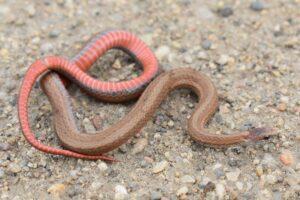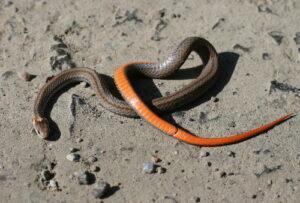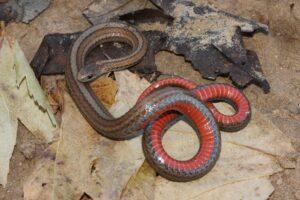
The redbelly or red-bellied snake is a small and thin woodland species native to North America. As the name suggests, its most distinguishing characteristic is its bright red, orange or pink belly. It is nocturnal, mild-mannered, and spends most of its life hiding under bark, rocks, logs, brush piles, and leaves. The colubrid remains active from May to October.
Scientific Classifications
- Suborder:Serpentes
- Family:Colubridae
- Genus: Storeria
- Species:S. occipitomaculata
Conservation Status
Subspecies
This snake has three recognized subspecies.
- Florida redbelly snake (Storeria occipitomaculata obscura)
- Northern redbelly snake (Storeria occipitomaculata occipitomaculata)
- Black Hills redbelly snake (Storeria occipitomaculata pahasapae)
Description
Size
The size of this snake is in the range of 4-10 inches (10-25 cm).
Color and Appearance
Their colors may vary from orange to gray, brown, or black. Their bright orange or red underbelly is their identifying trait. There are 3 orange or cream spots on its neck and faint stripes on its back. There can be a single broad stripe, or 4 narrow stripes, or a combination of both. The dorsal scales are keeled, and the pupils round.
Are They Dangerous to Humans
The red-bellied snake is non-venomous and hence, not dangerous. If caught or molested it often squirms vigorously, flattens its head and body, and releases an unpleasant-smelling musk from a pair of glands at the base of its tail. If further threatened, it displays a lip-curling behavior, exposing its upper teeth instead of biting.
Redbelly Snakes at a Glance
Distribution
The colubrid lives throughout the eastern United States, except in peninsular Florida.
Habitat
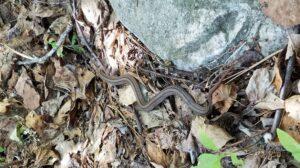
It prefers warmer habitats. In the northern parts of its range, it inhabits abandoned ant mounds. It is because such shelters allow them to have a longer active season as they absorb sunlight and are insulated. Plus, they don’t need the snake to burrow to a warm retreat as they are impaired in that front owing to their big eyes and kinetic skulls.
These secretive snakes can be found under leafy debris and logs.
Lifespan
Redbelly snakes live up to 4 years in captivity. But little is known about its lifespan in the wild.
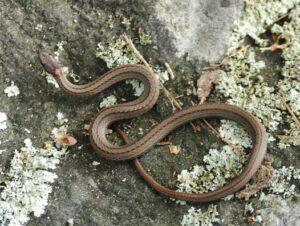
Predators
They are eaten by other snakes, birds of prey, skunks, raccoons, shrews, thirteen-lined ground squirrels, and domestic cats.
Diet
Its diet consists of slugs almost entirely. It also eats insects and earthworms.
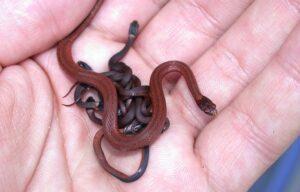
Reproduction
Viviparous (gives birth to live young)
Red-bellied snakes start mating from around 2 years of age if they reach a minimum length of 22 cm. They reproduce annually, with the females being gravid in spring and early summer. A litter can have 1-21 babies. The juveniles are darker than the adults and have a whitish band at the back of their heads.
Similar Species
Dekay’s Brownsnake
The Dekay’s brownsnake, Storeria dekayi, has a row of paired spots on its dorsum. It lacks the 3 spots on the neck and the red venter.
Copperhead
The venomous copperhead, Agkistrodon contortrix, has a stout body, an hourglass-shaped pattern on its back, vertical pupils, and a sensory pit between each eye and nostril.
Kirtland’s Snake
The Kirtland’s snake, Clonophis kirtlandii, also has a red belly, but it is outlined by round black spots that are absent in the redbelly snake.
Source
sdherps.org, herpsofnc.org, farm4.static.flickr.com, biokids.umich.edu, nps.gov

